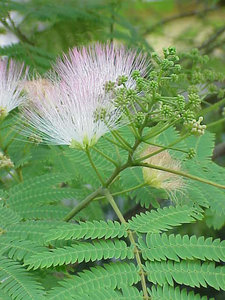
Pinyin: He Huan Pi Latin: Albizia Julibrissin
Common Name
Mimosa Tree Bark, Albizzia Bark
Physical Characteristics:
Albizia is a decidious Tree growing to 12m by 10m is hardy to zone 7 and is frost tender. The Persian Silk Tree is in flower from July to August, and the seeds ripen from September to November. The flowers are hermaphrodite (have both male and female organs). Albizia can fix Nitrogen. The plant prefers light (sandy), medium (loamy) and heavy (clay) soils, requires well-drained soil and can grow in nutritionally poor soil. The plant prefers acid, neutral and basic (alkaline) soils and can grow in very alkaline and saline soils though cannot grow in the shade. The Silk Tree requires dry or moist soil and can tolerate drought. The plant can tolerates strong winds but not maritime exposure.*
Family:
Edible Uses:*
Edible Parts: Flowers; Leaves. Edible Uses: Tea. Young leaves - cooked. An aromatic flavor, they are used as a potherb. Albizia Flowers - cooked. Eaten as a vegetable. The dried leaves are a tea substitute.*
Traditional Chinese Medicinal (TCM) Uses:*
Analgesic; Anthelmintic; Carminative; Digestive; Diuretic; Oxytoxic; Plaster; Sedative; Stimulant; Tonic; Vulnerary. The flower heads are carminative, digestive, sedative and tonic. They are used internally in the treatment of insomnia, irritability, breathlessness and poor memory.*
Albizia flowers are harvested as they open and are dried for later use. The stembark is anodyne, anthelmintic, carminative, discutient, diuretic, oxytocic, sedative, stimulant, tonic, vermifuge and vulnerary and is used internally in the treatment of insomnia, irritability, boils and carbuncles. Externally, it is applied to injuries and swellings. The bark is harvested in spring or late summer and is dried for later use. A gummy extract obtained from the Albizia plant is used as a plaster for abscesses, boils etc and also as a retentive in fractures and sprains.*
Other Uses*
Gum; Plaster. A gummy extract of the plant is used as a plaster. No more details are given. Wood - dense, hard, strong, takes a good polish. Used for furniture, industrial applications, firewood etc.*
References:
- Source: Albizia Julibrissin - Silk Tree Bark Extract Plants For A Future, England 1996-2008.
This work is licensed under a Creative Commons License.
Natural dietary supplements are designed to offer the body support to promote health, harmony, balance and overall well being.*

 Get Well Natural, LLC
Get Well Natural, LLC  Kidney Function & Regeneration Health
Kidney Function & Regeneration Health  Platelet & Blood Cell Health
Platelet & Blood Cell Health  Prostate, Flow & Function Health
Prostate, Flow & Function Health  General Mind & Body Health
General Mind & Body Health  Heart, Cholesterol & Cardio Health
Heart, Cholesterol & Cardio Health  Allergy-Free Body
Allergy-Free Body  Anxiety & Stress
Anxiety & Stress  Blood Platelet Counts & Function
Blood Platelet Counts & Function  Blood Pressure Health
Blood Pressure Health  Kidney Health
Kidney Health  Immune System Health & Balance
Immune System Health & Balance  Prostate & Urinary Health Function
Prostate & Urinary Health Function  Blood Sugar Balance
Blood Sugar Balance  Cardiovascular Heart Health
Cardiovascular Heart Health  Detoxification & Healthy Cells
Detoxification & Healthy Cells  Women's Health
Women's Health  Liver Regeneration
Liver Regeneration  Pain-Free Body
Pain-Free Body  Water & Air Filtration
Water & Air Filtration 


